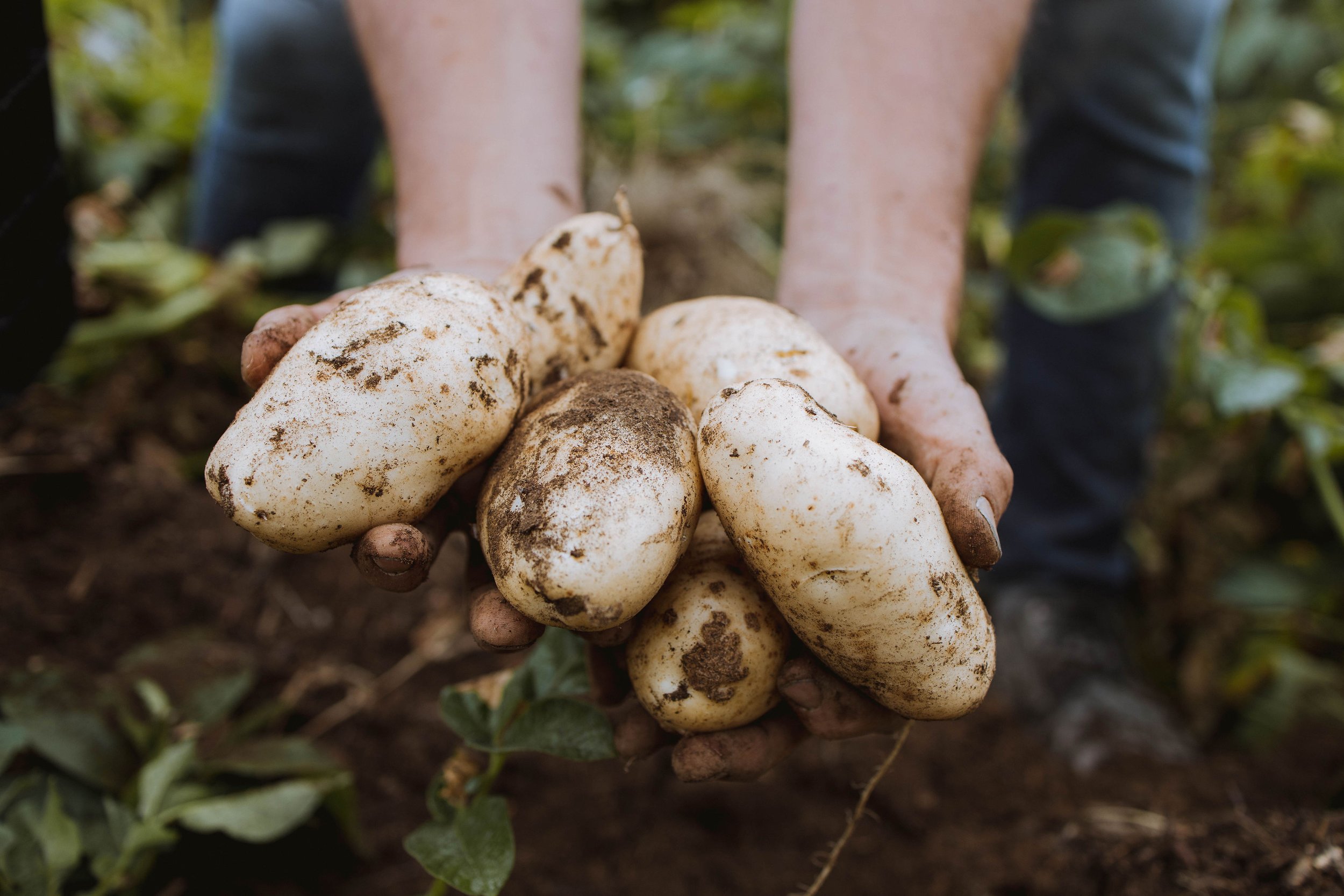Week 2 | 2024
A few years ago, I was dropping potatoes into long furrows when a rusty pickup ground to a stop on the
side of the road. The driver choked the engine and beckoned so I reluctantly made my way over to see
what he wanted. In a thick German accent, he told me that in the old country his grandmother’s
generation was required to grow potatoes for two years on any new farmland they acquired. I suddenly
became interested.
“Why?” I asked.
“Well, potatoes help condition the land,” he explained. “They break up hard soils and crops that follow
potatoes grow good.” Interestingly, these ideas weren’t foreign to us. We had learned this almost by
accident, but it was good to hear them confirmed by this old-timer.
One way to convert pastureland into a no-till garden is to apply a generous layer of cheap mulch to
suffocate the weeds. For us, composted woodchips provide the answer. But growing annual vegetables
like lettuce, peas, cabbage, and onions in this course material, even when topped with finer compost
can give bad germination, poor uniformity, and stunted growth. Though many of the minerals and
nutrients necessary for plant growth are present in a woodchip mulch, they’re not plant accessible. Our
first task, therefore, is to attract the community of life in the soil responsible for breaking down complex
molecules into smaller bits and making them available to plants for easy absorption.
By taking the advice of the old-timer and growing potatoes as your introductory crop in this mulch,
you’ll be rewarded with a good harvest of spuds, a weed-free garden and subsequent plantings of
vegetables will perform exceptionally well.
If you don’t have enough mulch to cover the ground with at least six inches, it’s a good idea to first
remove perennial weeds with a spade to prevent them from pushing through the organic layer. And if
you’re battling the greatest foes of all—morning glory, bind weed, knot weed, and horsetails—I offer my
sincerest regrets: this method won’t work for you.
Once the mulch has been applied, plant the potatoes four inches deep, eighteen inches apart and in
rows separated by three to five feet. When the potatoes emerge, mound them with a couple more
inches of composted chips and apply a generous amount (3 inches) of nitrogen-rich compost right on
top. I prefer well composted chicken, cow, or horse manure. When the potato stems and leaves emerge
a second time, they’re vibrant green.
We usually get enough rain and I seldom water potatoes through the summer. Mulch retains moisture
incredibly well. My brother, an irrigation specialist, is confounded when he sees how well our potatoes
do without irrigation. It’s the fungi, I explain. Specialized fungi, called mycorrhizal fungi, provide the
plant with moisture and nutrients in exchange for liquid sugars produced by the potato plant. It’s a
mutualistic association between organisms of different kingdoms that humans of the same family would
do well to take lessons from.
But fungi does more than just share with the plant. Fungi protects the plant from diseases and pests and
breaks down the tough lignin in the woodchips as they scavenge for nutrients to build up their biomass.
Fungi also provides an excellent food source for other soil food web members like bacteria, nematodes,
protozoa, mites, springtails, worms, beetles, and small rodents. And finally, fungi is instrumental in
binding soil particles together to form aggregates giving soil it’s crumbly structure.
Once you understand the importance of fungi, you’ll join me in strongly condemning fungicides that are
used in the commercial production of potatoes to control fungal related disease such as scab, scurf, and
blight. The collateral damage from fungicides is extensive, impacting organisms that feed on fungi and
killing off the mycorrhizal fungi potatoes and other plants need to thrive.
We often harvest our potatoes before the skins harden so that we have time to grow another crop
before winter. After potatoes we’ll apply more finished nitrogen-rich compost and successfully grow
winter cabbage, broccoli, cauliflower, lettuce, and endive. If the soil is fine enough to receive a seed,
we’ll often follow with beets or beans. If you let some of your potatoes reach full maturity and don’t
harvest until September, consider following with garlic or a winter cover crop.
Transitioning from a weedy, impoverished plot to a verdant, no-till garden takes time and growing
potatoes in the first year of no-till will reduce your stress level immensely. They’ll provide you with a rich
food source of food and improve your soil at the same time.
Sometimes, the old guys do know best.
Farm Grown Potatoes
When we started farming, our potatoes were often scabby and visually unappealing. They were also a
magnet for wireworm. But we never resorted to chemical use and instead focused entirely on building
healthy soils using cover crops and compost and we stopped disturbing the soil with aggressive tillers. As
land fertility improved, we began harvesting healthier and heavier crops of spuds. I’m not going to say
that potato diseases will no longer haunt us, but it seems that we’ve turned the corner on disease as
crop diversity brings greater balance to the farm ecosystem.
Conventionally, potatoes receive a heavy dose of chemicals while in the field and post harvest. At
planting time, potatoes are coated with pest inhibitors to reduce diseases. Fungicide and pesticide
sprays are used several times through the growing season to minimize damage from wireworm,
leafhoppers, beetles, blight, scurf, and scab. Herbicides are used to control weeds and a few weeks
before harvest a vine killer, often roundup, is applied to kill the potato plants and weeds making it easier
to harvest mechanically. Post harvest, farmers will use a chemical sprout inhibitors or radiation to make
sure the potatoes don’t sprout in storage. No wonder potatoes belong in the dirty dozen.
Because diversity is our farm signature, it’s difficult to mechanize and this means that most of the work
we do is by hand including planting, weeding, and harvesting. But because our soils are loamy and rich,
harvesting is done with ease and one strong farmer will harvest up to one thousand pounds of potatoes
per hour. I know it’s fraction of what a modern potato harvester, an absolute technological marvel, is
capable of, we feel that bringing clean food to the community while rebuilding soils and revitalizing the
natural ecosystem, can never be compromised.





